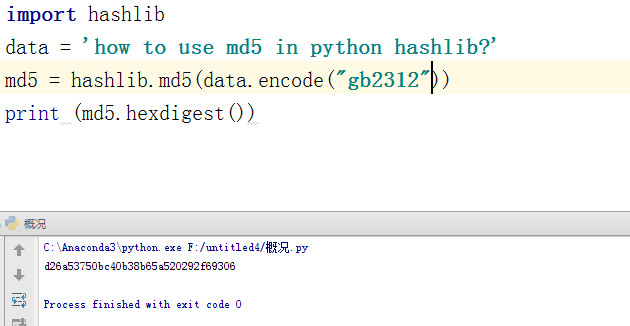

- #Python module for md5 encoding update#
- #Python module for md5 encoding software#
- #Python module for md5 encoding code#
import hashlib import base64 base64hashbase64.b64encode (hashlib.sha256 (inline.encode ('utf-8')).digest ()) sha 'sha256-' + code ('utf-8') print (sha) > This is generating a sha256 hash for a string with base64 encoding. The image processing time is a bit high. To solve that issue, please use the following way.Wrong inputs will affect the project outputs.Maintains security by ensuring only Admin can see the results of the image analysis.Useful to detect doctored images or signs of forgery in photos.Step5: Result is displayed on the admin page Step4: The encodings are compared, if the images are same then the encodings will also be same and hence no forgery has happened else forgery has happened Step3: Both the images are encoded using md5 hashlib Step2: We use Opencv to read image2(the image to be tested) Step1: We use Opencv to read image1(the original image) In this post I will share the method in which MD5 for each row in dataframe can be generated. The requirement was also to run MD5 check on each row between Source & Target to gain confidence if the data moved is accurate.
#Python module for md5 encoding update#
Use the MD5 Algorithm in Python To use the md5 algorithm, we will use the md5 () constructor and feed the hash object with byte-like objects using the update () method or pass the data as a parameter of the constructor.

This project is developed using the Django framework with Python as programming language. I was recently working on a project to migrate some records from on-premises data warehouse to S3. md5 is in the list of algorithmsguaranteed, but some FIPS compliant upstream vendors offer a Python build that excludes it. This image forgery detection project allows users to detect even the slightest signs of forgery in an image. Such doctored images can be used for malicious purposes such as spreading false information and inciting violence.
#Python module for md5 encoding software#
Moreover, the development in image processing software such as Adobe Photoshop has given a rise to doctored images. Electronics and Communication Project Ideasįollowing the explosion of social networking services, there has been a monumental increase in the volume of image data.If you are going to use base64 encoding anyway, it makes no sense to use hexdigest(). sandboxAPIKey 'wed23hf5yxkbmvr9jsw323lkv5g' sandboxSharedSecret '98HsIjh39z' def buildAuthParams(): authHash hashlib.md5() encoding because the update on md5() needs a binary rep of the string temp str.encode(sandboxAPIKey + sandboxSharedSecret + repr(int(time.time()))) print(temp) authHash.update(temp) look at the string representation of the binary digest print(authHash.digest()) now I want to look at the string representation of the digest print(code(authHash. Example (again using IPython and Python 3): In : import hashlib Second, using a hexadecimal representation doubles the length of a byte string the hex representation of one byte can vary between 00 and FF. Especially since / is not allowed in UNIX or MS-Windows filenames. Often + and / are used as symbols, but there are variations. This leaves two extra required symbols and a pading character. Generally they include lower- and uppercase letters, the digits 0-9. encode () will result in a sequence of bytes. Format: inputstring.encode (encoding, errors) This encodes inputstring using encoding, where errors decides the behavior to be followed if, by any chance, the encoding fails on the string.

The base64 alphabet uses 64 (or 2**6) different symbols. We use the encode () method on the input string, which every string object has. Step4: The encodings are compared, if the images are same then the encodings will. Step1: We use Opencv to read image1 (the original image) Step2: We use Opencv to read image2 (the image to be tested) Step3: Both the images are encoded using md5 hashlib.

With base64 encoding you get 8 bits of output for every 6 bits of input. This project is developed using the Django framework with Python as programming language. encodedmessage hashlib.md5 (b'Hello Welcome to AIM') converted encodedmessage.hexdigest () print (converted) If we do not want the message to be encoded in HEX string and show it in a sequence of bytes then we will use the digest function. (Example using IPython with Python 3): In : s = '123456789012345678901234' The hexdigest function will encode the message and return the encoded message as a HEX string. Charade Installation : For performing the detection and conversion of encoding, charade a Python library is required. Noob learning: Never be root, always do everything possible as non root user. I changed access of this somsub folder to unit:unit - but not the whole path starting from '/'. So, this step is important before processing the text further. If you start it manually, please share the env output in same shell session. First, base64 encoding makes strings longer. So, in such cases when the encoding is not known, such non-encoded text has to be detected and the be converted to a standard encoding.


 0 kommentar(er)
0 kommentar(er)
